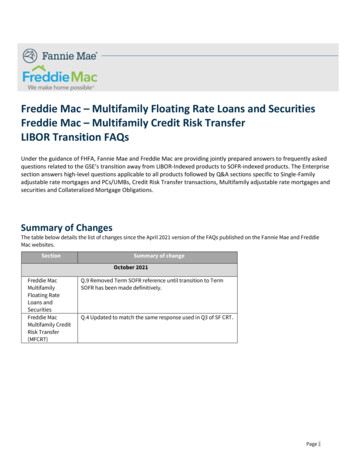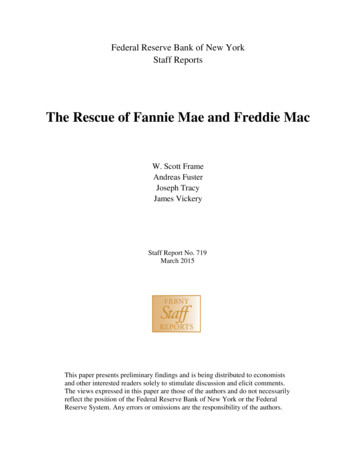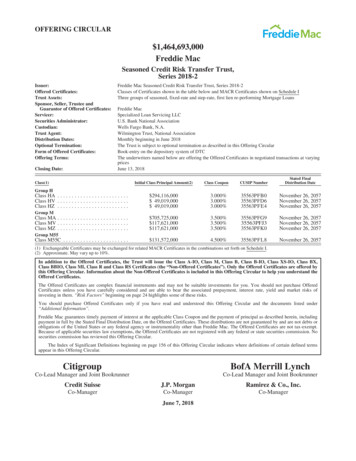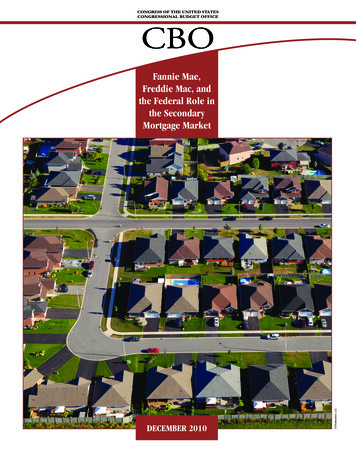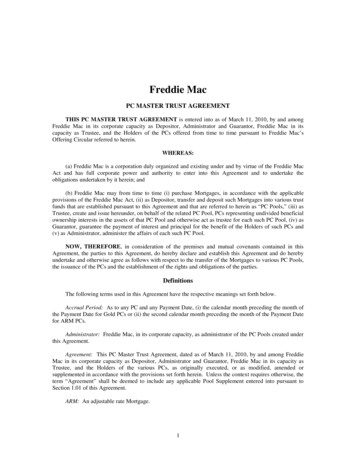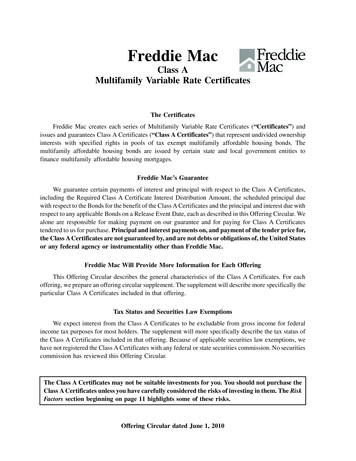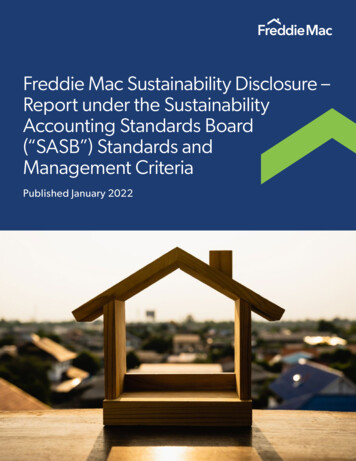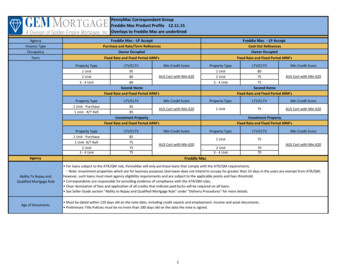
Transcription
Preferred EquityCredit Policy Update May 2016
What is Preferred Equity?Common EquityPreferred EquityMezzanine DebtPreferred EquityDebt (Inc. Mezzanine Debt)Investment of capitalInvestment is a loanUnsecuredSecuredFrom / to a member or partnerLender / borrower relationshipInvestor expects a preferredrate of returnLender expects interest andamortizationInvestor may have rights noother investor hasLender has default remedies incases of nonpaymentTerms are in a partnership oroperating agreementTerms are in a loan and/orintercreditor agreementPreferred Equity Freddie Mac2
Why Do We Care? If we are underwriting the preferred equity, and we like the investorwhy do we care?» Alignment of Interests– Potential influence on management decisions– Preferred Return vs. Investment in Property» Potential for ConflictPreferred Equity Freddie Mac3
Preferred Equity: How to Spot It What is the difference between hard pay preferred equity andsoft pay preferred equity?» When we hear soft pay preferred equity, we think common equity.» Common equity characteristics– Return on the equity investment is payable only out of net cash flowOR– Allows forgiveness or accrual of any return not paid because of alack of net cash flow.Preferred Equity Freddie Mac4
Preferred Equity: How to Spot It, Cont’d Preferred Equity (Hard Pay) has at least one of the following attributes:» The preferred return must be paid even if there is insufficient net cash flow,with no provision for forgiveness or accrual» A set redemption date (unless more than 1 year after loan maturity)» The right to exercise a control takeover based on the Property’s inability tomeet quantifiable performance measures such as occupancy or DSCR» Investor may require a forced sale if the preferred return or the preferredcontribution is not paidPreferred Equity Freddie Mac5
Hard Pay Preferred Equity Hard Pay Preferred Equity Underwriting Requirements:» Mortgage Preferred Equity investment must be 90% of property value» For fixed rate loans, NOI must be amortizing debt service Hard Pay by1.05x» For floating-rate loans, NOI must be amortizing debt service based on thecomparable fixed rate Hard Pay by 1.05x If the Preferred Equity return changes during the loan term, use theweighted average of all Preferred Equity returns to calculate Hard PaycoveragePreferred Equity Freddie Mac6
Redemption Dates If the Preferred Equity investment has a set redemption date during theloan term, the combined leverage threshold must be 85% atredemption» Based on remaining UPB of loan, preferred equity investment and projectedaccrued return on Preferred Equity relative to current valuePreferred Equity Freddie Mac7
Redemption Dates Redemption dates are permitted as follows:» Loan term 5 years. Redemption Date may not be:» During the term of the mortgage, or» Within 1 year after the maturity date» Loan term 5 years. Redemption Date may not be:» During the first 2 years of the mortgage,» During the last 2 years of the mortgage, or» Within 1 year after the maturity datePreferred Equity Freddie Mac8
Buy-Sell and/or Preferred Equity Analysis Buy-Sell and/or Preferred Equity Analysis is now needed:» Every time a buy-sell right is requested» If there is Preferred Equity, even if no buy-sell right is requestedPreferred Equity Freddie Mac9
Buy-Sell and/or PreferredEquity Analysis, Cont’d The Analysis is used to determine if there are rights available tothe preferred equity investor that are not acceptable, such as:» The ability to take over management of the subject property because offailure of another property owned by the same sponsor to attain certainmeasurable economic thresholds (Cross default)» The ability to extinguish the manager’s management right as well as itsequity interest» The right to change the terms of the preferred equity after the loan isoriginated unless the changes are already contemplated in theorganizational documents and have been approved by Freddie MacPreferred Equity Freddie Mac10
Buy-Sell and/or PreferredEquity Analysis, Cont’d The Analysis is also used to determine whether the equity iscommon equity (soft pay) or preferred equity (hard pay) and ifpreferred equity, whether it should be sized as hard pay orpartial hard pay» The Buy-Sell analysis no longer uses the terminology “preferredequity,” “hard pay,” “partial hard pay” or “soft pay”» Freddie Mac will examine the terms of the transaction and make thedetermination rather than relying on the labels usedPreferred Equity Freddie Mac11
Is This Preferred Equity? The equity partner may receive a higher return than the other partners(50/50 until 10% IRR is met, then 60/40 until 12% IRR is met). The equity partner has the right to require a forced sale after 4 years.The proceeds of the sale are distributed in the same manner as the netcash flow.ANSWER:NO – The higher return on equity until the IRR is met is a fairly standardcommon equity structure seen in many joint ventures. Just having theright to require a forced sale would not by itself put this into the preferredequity categoryPreferred Equity Freddie Mac12
Is This an Acceptable PreferredEquity Structure? The equity provider made its contribution into a joint venture that wasan indirect owner of both “X” borrower and “Y”, a related sponsor The Freddie Mac loans were not cross collateralized. The preferredreturn was required to be paid only if there was sufficient net cash flow The equity provider had the right to replace the manager of X if theoccupancy at property X or at the related property Y went below 85%ANSWER:NO – The failure to meet a measurable, economic trigger at anotherproperty, property Y, cannot trigger the change of management atproperty XPreferred Equity Freddie Mac13
Is This an Acceptable PreferredEquity Structure? The preferred equity provider is making an equity contribution into thejoint venture member of 4 borrowers that will receive crosscollateralized loans The preferred equity provider has the right to take over themanagement of the joint venture and thus take over the managementof all of the properties if the net operating income at any property is notsufficient to pay the preferred returnANSWER:YES – This is acceptable because the underlying Freddie Mac loans willbe cross collateralizedPreferred Equity Freddie Mac14
Is This an Acceptable PreferredEquity Structure? The preferred equity provider had the right to take over management ifthe manager failed to comply with the business plan The business plan contained measurable economic triggersANSWER:POSSIBLY OK – This may be an acceptable structure depending on theterms of the business plan. If the measurable economic triggers areacceptable then it will be underwritten as hard pay preferred equityPreferred Equity Freddie Mac15
Debt (Inc. Mezzanine Debt) Investment is a loan Secured Lender / borrower relationship Lender expects interest and amortization Lender has default remedies in cases of nonpayment Terms are in a loan and/or intercreditor agreement Preferred Equity Investment of capital Unsecured From / to a member or partner Investor expects a preferred rate of .
